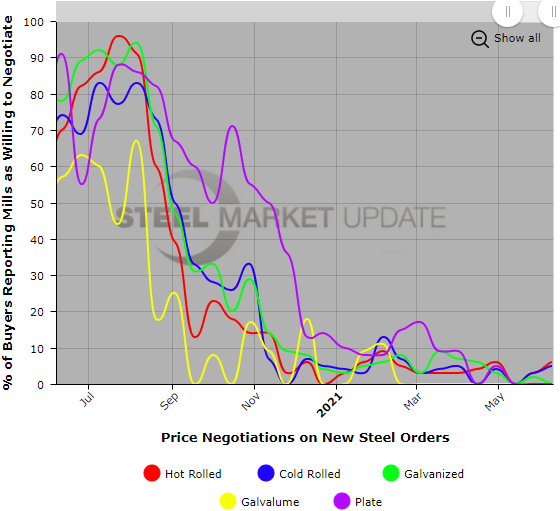SMU Data and Models

Steel Mill Negotiations Essentially Non-Existent
Written by John Packard
June 10, 2021
Steel buyers reported to Steel Market Update this week that the trend for steel mills to limit or totally remove any negotiations on spot steel prices continues.
![]() Steel pricing power is totally in the hands of the steel mills as supply continues to be less than the demand for mill products.
Steel pricing power is totally in the hands of the steel mills as supply continues to be less than the demand for mill products.
Steel Market Update went out to steel buyers representing manufacturing companies and steel service centers, and they reported (again) almost unanimously that prices were being held firm with no wiggle room.
When we look at negotiations by product, we found 94 percent of our hot rolled respondents reporting no ability to negotiate with their steel mill suppliers. Cold rolled was 95 percent reporting no ability to negotiate. Galvanized, Galvalume and plate steel buyers were unanimous (100 percent) that there was no ability to negotiate spot pricing with their steel mill suppliers.
One major reason for the hard line taken by steel mills: extended lead times. In other words, mills have strong order books and do not need to entice spot buyers with lower prices to place new orders.
The SMU Steel Mill Negotiation data is derived from our flat rolled and plate steel market trends analysis survey which we conduct every other week. If you would like to become a confidential data provider please contact us at info@SteelMarketUpate.com. To see an interactive history of our spot price negotiations data, visit our website here.

By John Packard, John@SteelMarketUpdate.com

John Packard
Read more from John PackardLatest in SMU Data and Models

SMU Scrap Survey: Sentiment Indices rise
Both current and future scrap sentiment jumped this month, though survey participants reported responses before key trade news was announced.

SMU Survey: Sentiment splits, buyers have better view of future than the present
SMU’s Steel Buyers’ Sentiment Indices moved in opposite directions this week. After rebounding from a near five-year low in late June, Current Sentiment slipped again. At the same time, Future Sentiment climbed to a four-month high. Both indices continue to show optimism among buyers about their company’s chances for success, but suggest there is less confidence in that optimism than earlier in the year.

SMU scrap market survey results now available
SMU’s ferrous scrap market survey results are now available on our website to all premium members. After logging in at steelmarketupdate.com, visit the pricing and analysis tab and look under the “survey results” section for “ferrous scrap survey” results. Past scrap survey results are also available under that selection. If you need help accessing the survey results […]

SMU flat-rolled market survey results now available
SMU’s latest steel buyers market survey results are now available on our website to all premium members. After logging in at steelmarketupdate.com, visit the pricing and analysis tab and look under the “survey results” section for “latest survey results.” Past survey results are also available under that selection. If you need help accessing the survey results, or if […]

SMU Survey: Sheet lead times stabilize, plate contracts
Mill lead times for sheet products were steady to slightly longer this week compared to our late June market check, while plate lead times contracted, according to steel buyers responding to this week’s market survey.
